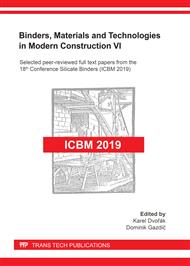[1]
J.L. Provis and J.S.J. Van Deventer (Eds.), Geopolymers: structures, processing, properties and industrial applications, Elsevier, (2009).
Google Scholar
[2]
Z. Tang, W. Li, Y. Hu, J.L. Zhou and V.W. Tam, Review on designs and properties of multifunctional alkali-activated materials (AAMs). Constr. and Building Mat. 200 (2019) 474-489.
DOI: 10.1016/j.conbuildmat.2018.12.157
Google Scholar
[3]
C. Lamuta, S. Candamano, F. Crea and L. Pagnotta, Direct piezoelectric effect in geopolymeric mortars. Materials & Design 107 (2016) 57-64.
DOI: 10.1016/j.matdes.2016.05.108
Google Scholar
[4]
B. Han, X. Yu and J. Ou, Self-Sensing Concrete in Smart Structures, Butterworth Heinemann, London, (2014).
Google Scholar
[5]
P. Rovnaník, I. Kusák, P. Bayer, P. Schmid and L. Fiala, Comparison of electrical and self-sensing properties of Portland cement and alkali-activated slag mortars. Cem. and Concr. Res. 118 (2019) 84-91.
DOI: 10.1016/j.cemconres.2019.02.009
Google Scholar
[6]
B. Han, S. Ding, X. Yu, Intrinsic self-sensing concrete and structures: A review. Measurement 59 (2015) 110-128.
DOI: 10.1016/j.measurement.2014.09.048
Google Scholar
[7]
S. Rana, P. Subramani, R. Fangueiro and A.G. Correia, A review on smart self-sensing composite materials for civil engineering applications. AIMS Mat. Science 3(2) (2016) 357-379.
DOI: 10.3934/matersci.2016.2.357
Google Scholar
[8]
N. Ranjbar, M. Mehrali, M. Mehrali, U.J. Alengaram and M.Z. Jumaat, High tensile strength fly ash based geopolymer composite using copper coated micro steel fiber. Constr. and Building Mat. 112 (2016) 629-638.
DOI: 10.1016/j.conbuildmat.2016.02.228
Google Scholar
[9]
S. Wen and D.D.L. Chung, A comparative study of steel-and carbon-fibre cement as piezoresistive strain sensors. Advances in cement research 15(3) (2003) 119-128.
DOI: 10.1680/adcr.2003.15.3.119
Google Scholar
[10]
C. Mizerová, I. Kusák, P. Rovnaník and P. Bayer, Steel microfibres in fly ash geopolymer for multifunctional conductive composites. IOP Conference Series: Mat. Science and Engineering 596(1) (2019) p.012014.
DOI: 10.1088/1757-899x/596/1/012014
Google Scholar


